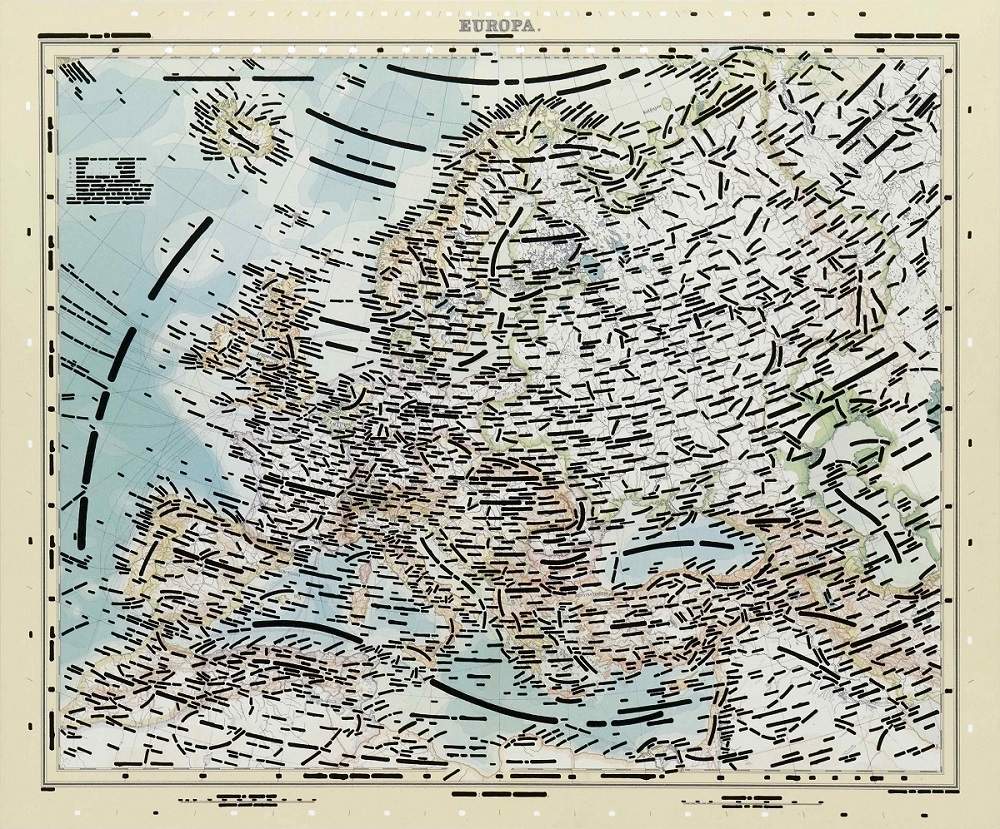In Treviso, the Imago Mundi Foundation, in collaboration with the City of Treviso, presents from Saturday, October 15 to Sunday, December 11, 2022, the exhibition Europe Doesn’t Fall from the Sky. Reflections through contemporary art, an exhibition appointment that aims to offer a reflection on our continent in the present time, its challenges and opportunities. The exhibition is developed as an itinerary within the city of Treviso and involves four venues: the Gallerie delle Prigioni, Ca’ Scarpa, Casa Robegan and the Museo Luigi Bailo.
Europe does not fall from the sky presents a selection of works by twenty artists: Matthew Attard, Gabriele Basilico, Maurizio Cattelan, Jasmina Cibic, Braco Dimitrijević, Claire Fontaine, Olexa Furdiyak, Marco Godinho, Dan Halter, Emilio Isgrò, Yurii Ivantsyk, Annette Lemieux, Richard Mudariki, Arcangelo Sassolino, Santiago Sierra, Giulio Squillacciotti, Slavs and Tatars, Giuseppe Stampone, Paolo Ventura, and Dominique White. Using diverse artistic practices (from installation to painting, sound to photography to video), the artists in the exhibition invite consideration of issues debated in Europe today.
These works are complemented by a selection of more than 40 collections from Imago Mundi Collection dedicated to European countries. The works on display, in the 10x12 cm format, combine to express the varied and fascinating richness of our continent’s visual and conceptual culture, in an embrace that extends from the Mediterranean to the Arctic.
The title of the exhibition is inspired by a text by Altiero Spinelli, considered by many to be one of the fathers of European federalism, who in his writings after World War II exposes and anticipates some of the issues that were urgent at the time and are still relevant today, such as the creation and development of a European identity, the management of energy sources, the role of European diplomacy in the international chessboard and the commitment to peace. The exhibition aims to contribute to reflection on the identities of today’s Europe, also in view of the challenges it has faced in recent years: from migratory flows to the health emergency, from the climate crisis to geopolitical events and recent conflicts. Precisely to deepen this discussion, the exhibition also includes a calendar of appointments with journalists, scholars and researchers, and experts in international politics. They are asked to help understand the meaning of community, going beyond national and European borders. The first meeting, titled “How War Changes the World,” takes place on Monday, Oct. 17, at 6 p.m. at Palazzo dei Trecento, Treviso, with Lucio Caracciolo, editor of Limes.
At the Gallerie delle Prigioni, the focus is on European cultural identity, with the Imago Mundi collections dedicated to the countries of the eastern region. All the works show how Europe has always been a melting pot of cultures, languages and traditions that coexist and at the same time create dissonance and conflict when hybrid realities become forced cohabitation.
At Ca’ Scarpa the focus is on the concept of encounter between different cultures, between North and South, and it finds expression in Stadium, a work by Maurizio Cattelan, presented here after 30 years since his last exhibition in Italy: a table soccer over 6 meters long with 22 stations, 11 on each side, that is activated by artistic happenings in which two teams face each other. Completing the exhibition are the Imago Mundi collections dedicated to Northern Europe.
At Casa Robegan, the focus is on the Mediterranean, with Imago Mundi collections from countries bordering it. An exploration of the mental and physical boundaries that delimit the European continent is proposed here, with the sea having always represented a barrier that, while on the one hand stops the journey, on the other opens new horizons.
Finally, the Luigi Bailo Museum hosts the Imago Mundi Collection dedicated toItaly, which complements the current exhibition on Antonio Canova, in an ideal red thread linking neoclassical and contemporary art and celebrating the artistic genius and creativity of our country.
Image: Emilio Isgrò, Europe Q99 (Rome, Emiliano and Ottavia Cerasi Collection)
 |
| From Isgrò to Cattelan, an exhibition in Treviso on Europe in the present time |
Warning: the translation into English of the original Italian article was created using automatic tools. We undertake to review all articles, but we do not guarantee the total absence of inaccuracies in the translation due to the program. You can find the original by clicking on the ITA button. If you find any mistake,please contact us.